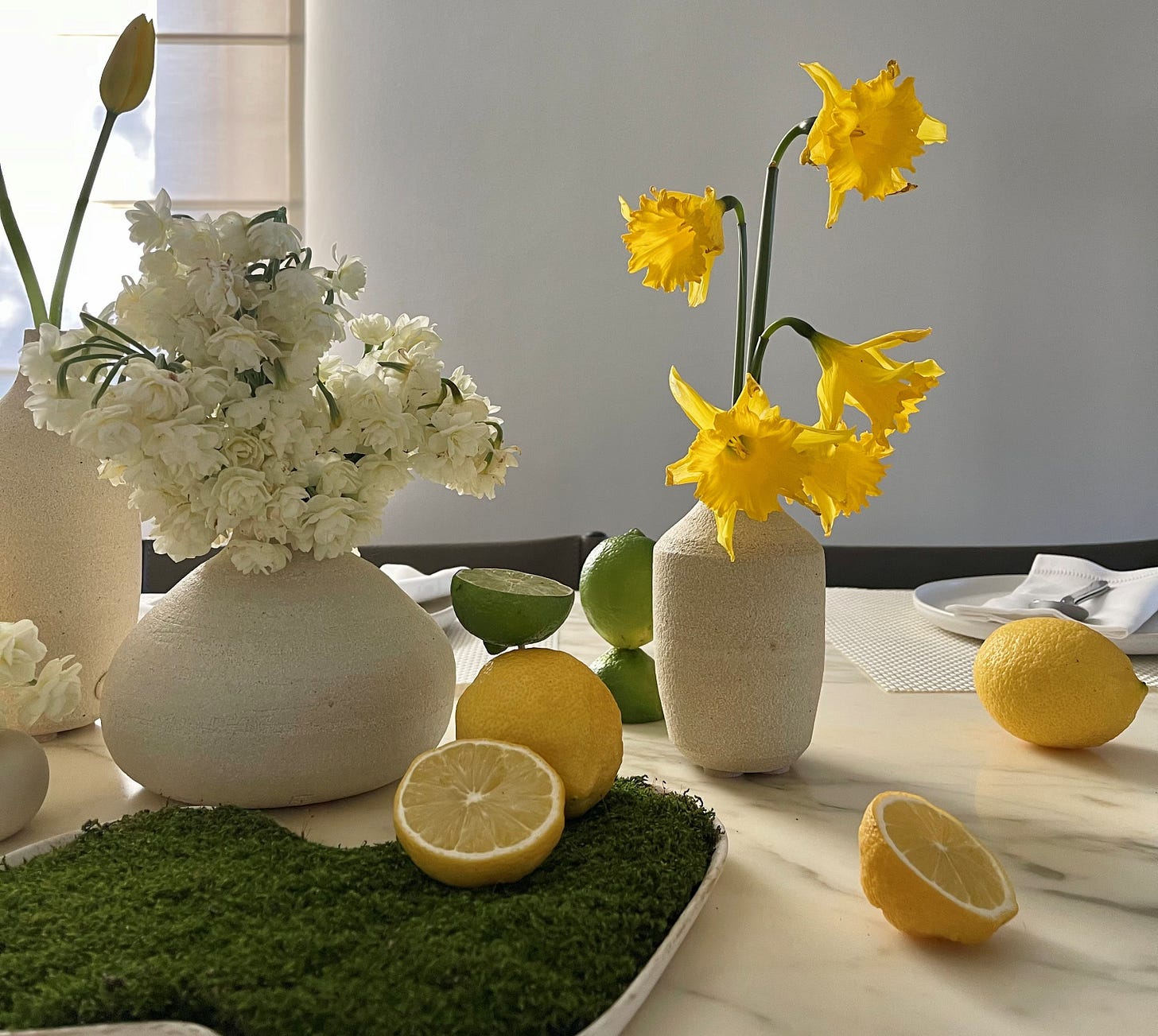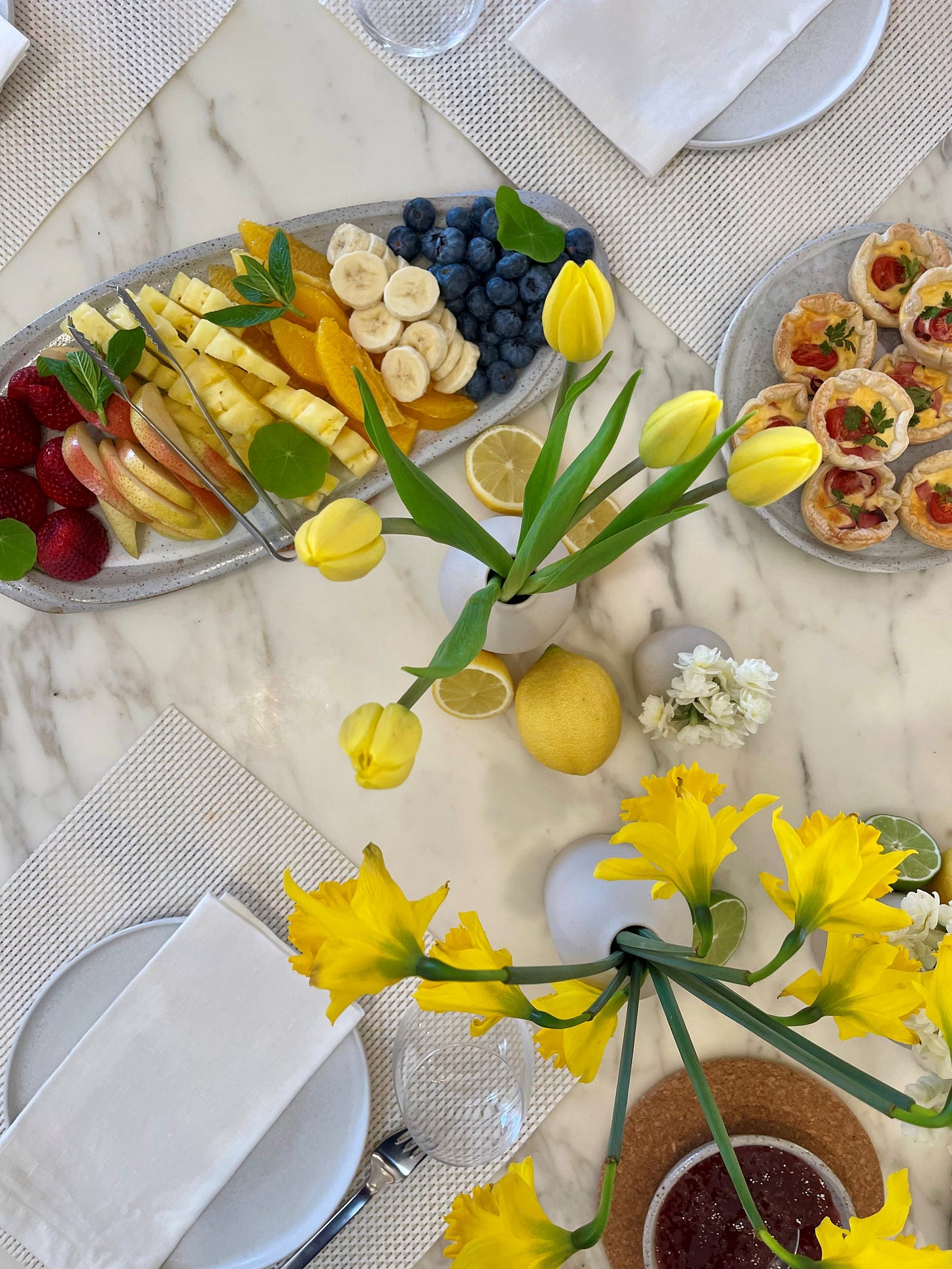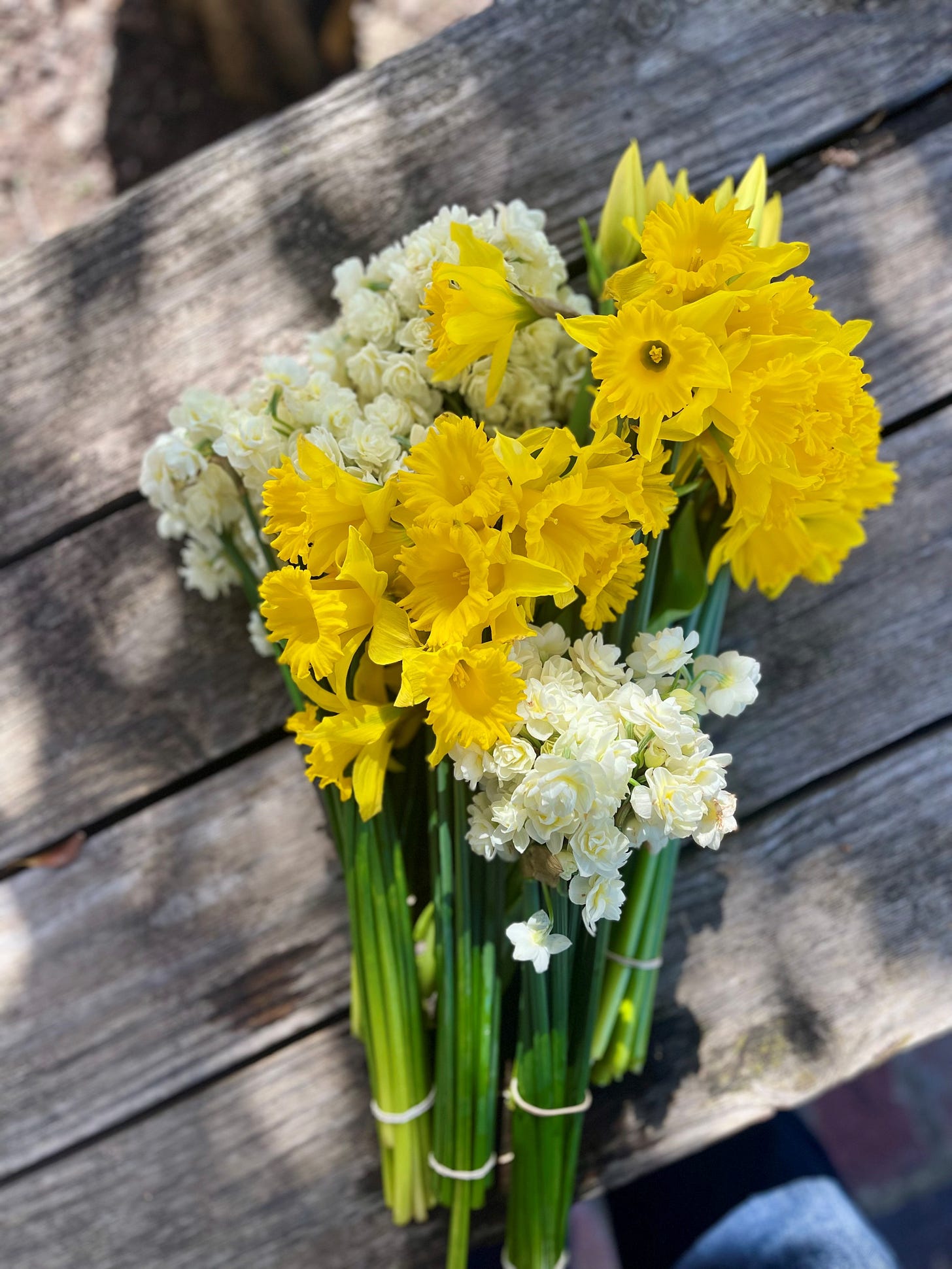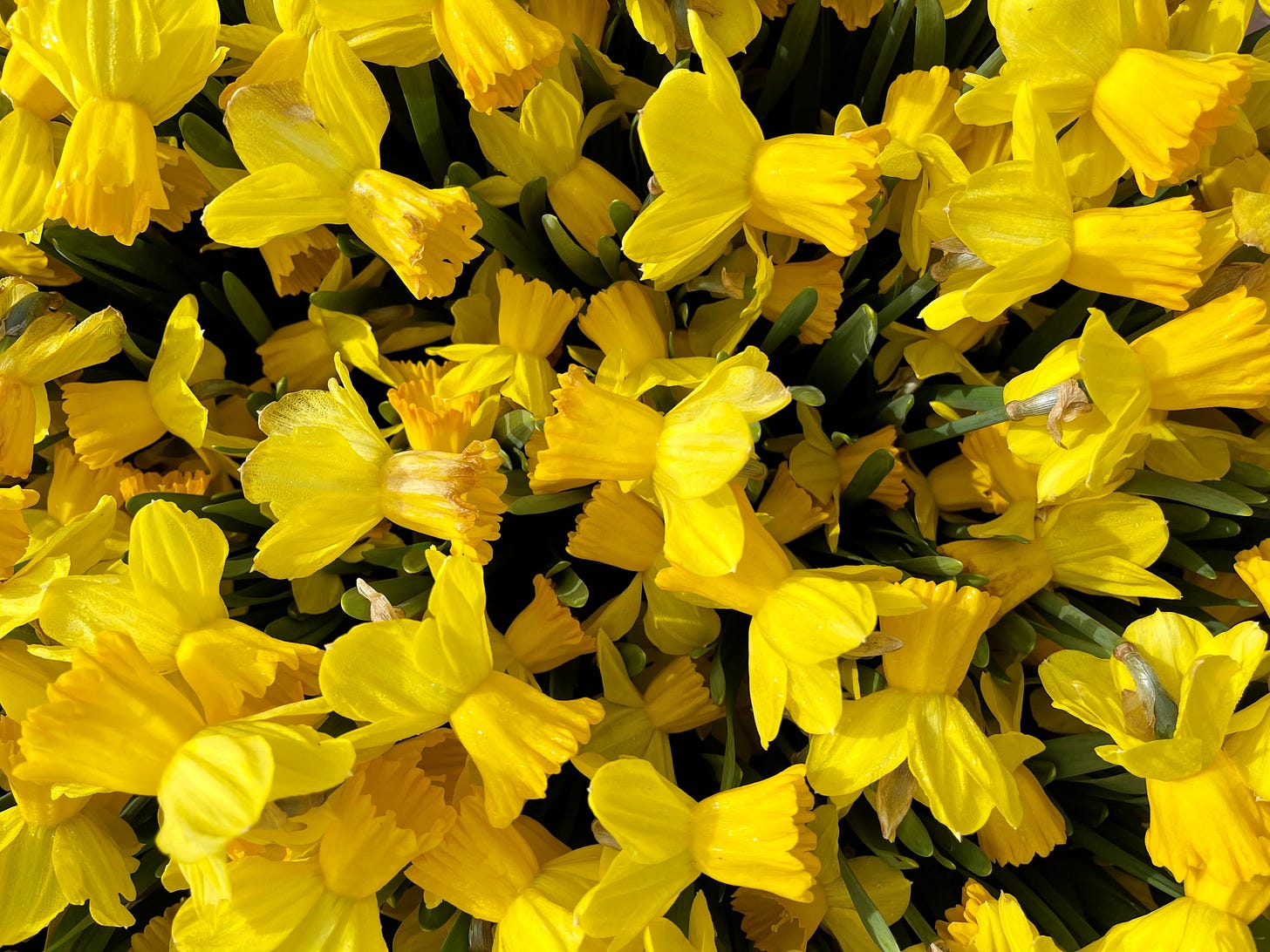Today on the Flowerlogue…
Hi Flower Friends, so glad you are here and if you’ve stumbled across my newsletter, welcome! I’d be chuffed to share my flowers stories with you. It’s easy just click below.
For the best viewing experience, be sure to read this post on your desktop or via the substack app. By the way, all photographs in this story are taken by me.
Firstly, a quick note - apologies for the delay in this week’s post. The G and I have just moved my father into a retirement apartment, and we’ve purchased his house as an investment property. And let’s just say it has taken over more of our lives than we anticipated. What was meant to be a straightforward refresh has been slowed by broken bits, tricky tradespeople, and my ongoing indecision about paint colours. So, this week’s post is a little shorter than usual, but I still wanted to share something quirky yet lovely with you.
Seasonal Blooms That Ground Us
The jonquils in our front garden have just started to bloom. A quiet sign that the local bulb flower season is returning to the markets. Daffodils, erlicheer, tulips and jonquils, all locally grown and beautifully fresh. There’s something so grounding about seasonal flowers. They last longer, they support local growers, they use much less travel miles and they don’t require pesticides to enter the country. They’re also wonderfully affordable, which makes it easy to bring a little beauty into your home with a couple of cheerful bunches.
A Morning Tea Arrangement with Meaning
Last August, I created a simple morning tea arrangement using the locally grown blooms, my favourite handmade ceramic vessels, a few new flat, curvy-edged dishes I’d been waiting to try, a glut of lemons from our backyard tree, and 5 bunches of bulb flowers from our wholesale flower market. It was one of those quietly satisfying moments, pulling together a table setting that felt fresh and intentional without needing a huge number of ingredients.
The pairing of fruit and flowers in arrangements has long been part of floral tradition - from traditional tablescapes to still life paintings. Today, fruit and vegetables integrated into floral arrangements is very entrend. You just need to look at Hamish Powells’ recent Instagram post where he paired heirloom tomatoes, cherry tomatoes with pitcher plants and red tropical flowers for a Loewe perfumes promotion.
My preference is for the more updated version: fewer materials, gently grouped to create clarity and calm. For this arrangement, I kept the palette soft and clean - lemon, green, and white. These analogous tones of green and yellow, sitting side by side on the colour wheel, brought a quiet freshness to a spring table.
A Personal Story: Lemons with a Cause
The lemons in the arrangement came from the same tree my son, Andrew, once used for his school fundraising efforts. He’d set out a basket on our verge, offering lemons to passing neighbours. At first, they were ten cents each. He quickly learnt that he could double the price and still sell the same amount. The proceeds went straight to the Perth Zoo, in support of the western swamp tortoise, a local, endangered tortoise that he was crazy interested in at the time. Over time, he raised more than $400, a remarkable amount when you think about how many lemons that must have been. The story even made it onto the West Australian newspaper, where he was interviewed alongside the State Minister for the Environment.
The Arrangement: What I Used
1 bunch Yellow tulips
2 bunches of Daffodils
3 bunches of Erlicheer
8 Homegrown lemons
5 Limes (repurposed into our gin and tonics)
1 sheet of Farmed moss (I’m still investigating the source - but it’s not wild-foraged)
A collection of off-white ceramic vessels
Wooden skewers, for skewering the lemons and limes
I arranged the flowers at varying heights across the table, using the vases to create a sense of rhythm. The moss was laid into my new low, flat dishes with soft, curving edges. They reminded me of miniature golf greens, and I joined several of the whole and halved lemons together with the skewers and nestled them into the bases of the vases. I kept the lower vases on the ends of the arrangement and stepped up the height toward the centre of the table. I mixed single stems with small groupings of blooms for texture and movement.
The scent was extraordinary - the sweet intensity of the erlicheer blending with the tangy citrus notes in a way that felt both crisp and comforting.
Tips for Simple Table Arrangements
Vary the heights of your vases and flowers to give a sense of movement
Keep stems under 30cm (or roughly a hand-and-forearm height) so guests can see across the table
Use a simple colour palette for both vessels and flowers to keep the eye relaxed
Group some flowers and use the occasional single stem for softness
I like to create asymmetrically to add interest. Balance out with a larger serving plate
Have a variety of textures - smooth shininess of the lemons and limes, roughness of the vases, fuzziness of the moss
Arrange vases casually so they can be moved easily to make way for serving dishes
A ‘KISS’ Story
I’m a believer of the ‘keep it simple, stupid’ saying. More often than not the simplest combinations, seasonal flowers, fruit from the garden, and a few vessels you love, come together to tell a quiet, beautiful story.
If you’re at the markets in the coming weeks or have just a few flowers blooming in your garden, I encourage you to pick them and see what you might create with what’s already around you.
If you’d like to see more of my floral designs, you can find me on Instagram at Cerina Floral Atelier.
And if you love my flower journeys, florist tips, and blooming banter. I’d love you to join my fanatical paid subscribers group.

















Fantastic tips and absolutely love the lemon story you told about your son!
I love the story of your son and the lemons. My young daughter is very enthusiastic about animals, as your son was. I’m making a tablescape this week with fruits for the first time. Your tips have been helpful!